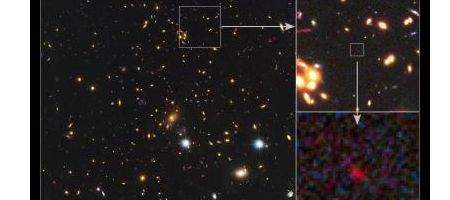Astronomers have discovered their most distant – and therefore oldest – galaxy yet, using NASA’s Spitzer and Hubble space telescopes as well as gravitational lensing.

The observations show the galaxy at the end of the so-called Dark Ages, when the first stars were forming.
“This galaxy is the most distant object we have ever observed with high confidence,” says Wei Zheng of The Johns Hopkins University. “Future work involving this galaxy – as well as others like it that we hope to find – will allow us to study the universe’s earliest objects and how the Dark Ages ended.”
The galaxy’s an astonishing 13.2 billion light years away, meaning the light captured by the telescopes left it when the universe was just 3.6 percent of its present age. It has a redshift of 9.6, defining how much its light has shifted into longer wavelengths as a result of the expansion of the universe.
To help gather data, the astronomers used gravitational lensing – a helpful phenomenon whereby the gravity of foreground objects warps and magnifies the light from those further away.
The team was able to take advantage of a massive galaxy cluster situated between the new-found galaxy and our own, which magnified the former’s light to brighten it by 15 times.
The team believes the galaxy is being seen at a time when it was less than 200 million years old. It’s small and compact, which bears out this theory: the first galaxies are believed to have started out tiny.
And it’s these early galaxies which are believed to have kick-started the creation of the universe as we know it today.
About 400,000 years after the Big Bang, neutral hydrogen gas formed from cooling particles. And it’s the energy released by the earliest galaxies that’s believed to have ionized this hydrogen, putting it in the state it remains in to this day.
“In essence, during the epoch of reionization, the lights came on in the universe,” said paper co-author Leonidas Moustakas, a research scientist at NASA’s Jet Propulsion Laboratory.






